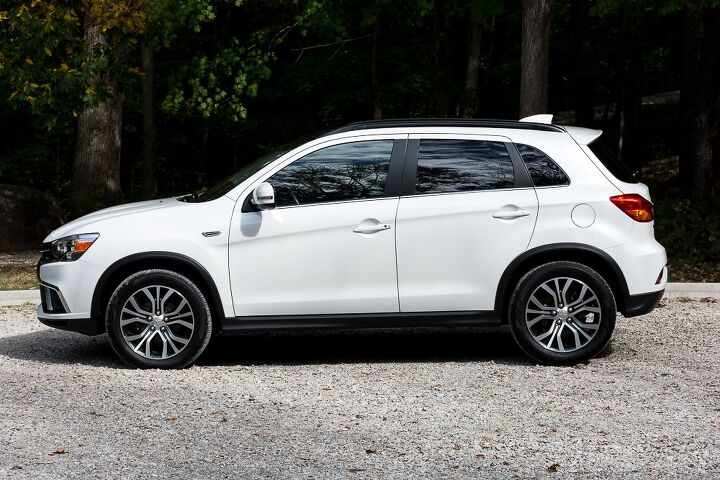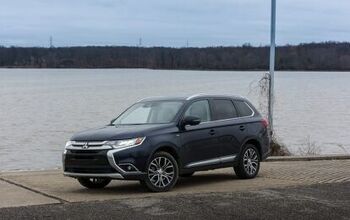2018 Mitsubishi Outlander Sport Review - In the Shadows

2018 Mitsubishi Outlander Sport 2.4 SEL AWC
Crossovers are the future. As much as I hate to say it, more and more buyers vote with their wallets every year, choosing a smaller-yet-taller, less fuel-efficient alternative to the traditional sedan. Automakers would build nothing but brown, diesel, manual station wagons if buyers would buy them — so you can’t fault the manufacturers for tossing every possible permutation of the CUV as chum for the always-hungry shopper.
Mitsubishi is no different. Of the four distinct models it offers here in the States, three are crossovers. But which one is right for you? Today, we look at the 2018 Mitsubishi Outlander Sport, the smallest of the trio. Is it distinct enough to be worthy of your driveway?
The interior of the Outlander Sport works well — the age of the design is evident in places, but the materials all seem to be of good quality, if a bit hard in places where soft-touch plastics have become common in the competition. As many automakers have moved toward touchscreen controls for heating and cooling, I welcome the three simple knobs to adjust temperature, fan speed, and vent locations.
As Tim noticed in his review of the Outlander Sport last winter (and as I noted while driving the big-brother three-row Outlander in the spring), the seats rock. I don’t mean that in a Drew Carey, “Cleveland Rocks!” manner — the driver and front passenger seats literally rock back and forth under acceleration. It’s a weird sensation, as if the floorpan itself is flexing under the stress of an overfed journalist. The rear seats, however, don’t flex. The bottom cushion in the rear is a bit flat, but the kids were plenty comfortable.
The location and size of the four-wheel drive control button is unfortunate, however. It’s immediately forward of the shift lever, right where the driver might set a cellphone. After all, the USB ports are RIGHT THERE. In a rush to unplug my phone, I stabbed the 4WD button at least once. I’d imagine that if a passenger (because no driver would EVER touch their phone while driving, right?) grabbed a phone from that location while the Outlander Sport was at speed, there may be some nastiness from the drivetrain.
Most front-drive based all-wheel drive systems don’t need a button to toggle all-wheel drive — it’s computer controlled. This is an odd remnant from Mitsubishi’s heritage of building hard-core off-roaders with legitimately selectable four-wheel drive. I’ll grant that I didn’t take the Outlander Sport off-road, so I can’t say for certain that it can’t handle terrain, but from the 55-series tires mounted on 18-inch wheels, I can make an educated inference.
Driving the Outlander Sport is a surprisingly decent experience. Continuously Variable Transmissions seem to be getting better all the time, including the unit fitted to this car. Other than the very occasional situation where the engine speed would hang a bit too fast for the situation — during abrupt throttle cuts when encountering an elevation change, for example — I hardly noticed any ill effects of the CVT.
Handling is similarly competent. A long drive on the freeway south from Detroit was my introduction to the Outlander Sport, and the ride was as good as most crossovers in the class. Road noise was elevated compared to others in the class; however, the optional nine-speaker Rockford Fosgate audio system helped drown out the road with the help of Android Auto and Spotify.
Let’s consider the styling. The odd shutline for the hood creates a funky pugnose effect when viewed head-on, much like a overweight football player wearing a Breathe Right strip over his oft-broken nose. The gaping black trapezoid created by that shutline, the polished chrome bar across the upper grille, the piano-black bumper beam cover, and the flat-black lower grille is a study in mating dissimilar materials into a disharmonious polygon. Beyond that nose, the rest of the Outlander Sport is unremarkable and inoffensive.
My big problem with the Outlander Sport is its place in Mitsubishi’s lineup. Now that the Eclipse Cross is available, the Outlander Sport seems redundant. The two crossovers share identical wheelbase and ground clearances, and similar overall dimensions inside and out. The Outlander Sport has more power, but the turbocharged 1.5-liter four in the Eclipse Cross offers more torque. Combined EPA fuel economy is identical. And yet the Eclipse Cross is a much newer design released in 2018, while this Outlander Sport was unveiled in 2010, with a few styling refreshes over nine model years.
I’ve only spent a few minutes in the Eclipse Cross so far, but the near-decade between the two crossovers is evident in moments behind the wheel.
Mitsubishi tells me that future generations will move the Outlander Sport downmarket, as a smaller, less-expensive complement to the more-mainstream Eclipse Cross. That’s probably the right move, because at this tester’s $29,310 delivered price, there are more compelling options nearly everywhere. Even on the same lot.
[Images: © 2018 Chris Tonn/TTAC]

Some enthusiasts say they were born with gasoline in their veins. Chris Tonn, on the other hand, had rust flakes in his eyes nearly since birth. Living in salty Ohio and being hopelessly addicted to vintage British and Japanese steel will do that to you. His work has appeared in eBay Motors, Hagerty, The Truth About Cars, Reader's Digest, AutoGuide, Family Handyman, and Jalopnik. He is a member of the Midwest Automotive Media Association, and he's currently looking for the safety glasses he just set down somewhere.
More by Chris Tonn
Latest Car Reviews
Read moreLatest Product Reviews
Read moreRecent Comments
- Probert They already have hybrids, but these won't ever be them as they are built on the modular E-GMP skateboard.
- Justin You guys still looking for that sportbak? I just saw one on the Facebook marketplace in Arizona
- 28-Cars-Later I cannot remember what happens now, but there are whiteblocks in this period which develop a "tick" like sound which indicates they are toast (maybe head gasket?). Ten or so years ago I looked at an '03 or '04 S60 (I forget why) and I brought my Volvo indy along to tell me if it was worth my time - it ticked and that's when I learned this. This XC90 is probably worth about $300 as it sits, not kidding, and it will cost you conservatively $2500 for an engine swap (all the ones I see on car-part.com have north of 130K miles starting at $1,100 and that's not including freight to a shop, shop labor, other internals to do such as timing belt while engine out etc).
- 28-Cars-Later Ford reported it lost $132,000 for each of its 10,000 electric vehicles sold in the first quarter of 2024, according to CNN. The sales were down 20 percent from the first quarter of 2023 and would “drag down earnings for the company overall.”The losses include “hundreds of millions being spent on research and development of the next generation of EVs for Ford. Those investments are years away from paying off.” [if they ever are recouped] Ford is the only major carmaker breaking out EV numbers by themselves. But other marques likely suffer similar losses. https://www.zerohedge.com/political/fords-120000-loss-vehicle-shows-california-ev-goals-are-impossible Given these facts, how did Tesla ever produce anything in volume let alone profit?
- AZFelix Let's forego all of this dilly-dallying with autonomous cars and cut right to the chase and the only real solution.












































Comments
Join the conversation
I chimed in before. Having actually owned a Mitsubishi brand vehicle previous and currently the owner of two 2015 Outlander Sports some takeaways. I have both an ES and SE/GT premium. The vehicle as well as interior on my ES has held up well with over 120K miles so far. I fully expect to achieve 300+ Outdated? Not on your life. It works. No rattles no issues and my ass doesn't hurt from a typical long drive. What more can you expect. My wife has the SE/GT and has 20K miles. The days of trading after a few years is over for me. I am keeping mine longer. I have had many brands and have an 864 credit score and CAN buy anything I want. All SUV's and CUV's look the same. I wanted the best deal but more importantly want longevety. Can't get that in a GM, Ford or FCA. In the years to come I fully expect to be driving my Mitsu all the while seeing more expensive examples in the bone yard way before mine.
I think it's a sold proven sub compact cuv in the space as it was one of the first (after suzuki sx4). One of the big things Mitsubishi should be doing is drop the price on this model to be a volume/value cuv and pick up buyers who are looking for deal and tap into the demos that used to buy jeep patriots. Before Mitsu joined the Alliance I think they had the best business case to do what toyota did in the 80's but this time around with the outlander cuvs. They could've undercut everyone on price and move more units by offering affordable, if not slightly old proven cuvs. Then once they joined the alliance in a year pricing went up like crazy which will backfire on the brand as people won't buy the brand when they can buy something better. So if mitsubishi offered 3 cuvs priced to undercut everyone, and a small pickup as america's most affordable pickup they would be killing it. But no, quick greed and trying to squeeze out more money per few models sold wins again. What a lost opportunity for Mitsubishi to be the kia, Huyndai, toyota etc of the suv/truck world by offering value